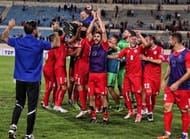The January FIFA Rankings are out and India have climbed three places to be ranked 102 globally. In Asia they are now ranked 14, sandwiched between recently crowned Gulf Cup champion, Oman (101), and Qatar (103), with the three teams separated by a mere eight ranking points.
What has now become evident is that India's hopes of making it to Pot 2 of 2019 AFC Asian Cup are all but over and in all likelihood, they will be consigned to Pot 3. They are scheduled to play a single match before the draw for the final tournament takes place on April 27.
A lot had been said regarding the number crunching by AIFF to attain high rankings in order to get a favourable draw for the continental tournament. While India had hoped to battle for the last Pot 2 slot, one team which has stolen the march over others is Lebanon.
In the recently published rankings, Lebanon are ranked at 84 with 407 ranking points. They are scheduled to play at home against Malaysia on March 27, the same day India will be playing Kyrgyzstan in Bishkek to wrap up the qualification round for Asian Cup. Both Lebanon and India have already sealed their berths for the tournament and the matches will also be their last before the main draw takes place. However, Lebanon looks poised to be drawn in Pot 2.
What makes this noteworthy is that ten months back, in March 2017, Lebanon were languishing at 155 in rankings. Their 71 place jump in rankings is almost concurrent with India's spurt in FIFA rankings. Lebanon were even scheduled to play a friendly in India on June 7 last year but had to be cancelled over visa problems.
The similarities are unmissable
Like India, Lebanon failed to advance in the 2014 FIFA World Cup Qualifiers and could not qualify for the 2015 edition of AFC Asian Cup. This prompted The Cedars to make certain changes on and off the field. The likes of Mohammad Ghaddar and Hassan Maatouk took it upon themselves to rebuild the team for a nation blighted by frequent sectarian conflicts. Like India, they are on an unbeaten run of 13 games and haven't lost a single game in 2017.
Not a fluke, but sustained efforts
The Lebanese Football Federation decided to implement a model on the lines of the famed 'Belgian Model' which paid off for Belgium in the run-up to the 2014 World Cup. They started reaching out to players from the Lebanese community in countries like United States, Colombia, Germany, Denmark, Norway.
Unlike India, Lebanese laws allow dual citizenship. This meant professionals willing to play for Lebanon need not surrender their original passport which would have disrupted their professional careers abroad. So unlike Danny Batth who was given the cold shoulder by AIFF, Hilal el Helwe, a Hanover born striker went on to don the Lebanese jersey.

Bring on board quality coaches
The likes of Theo Bücker and AS Roma legend Giuseppe Giannini were brought in as coaches as the team notched up some impressive results against Thailand, Kuwait, Myanmar. The International Media even went on to compare their resurgence to that of Bosnia-Herzegovina after they drew the Brazillian Olympic team 2-2 in Doha in 2014. Current national team coach, 50-year-old Miodrag Radulovic, has coached clubs in a host of countries before taking up the job and has stated his policy of promoting young talents in the team.
After the Russia 2018 campaign, we completely revamped the squad, bringing in ten new players. We’ve been working our socks off during national training camps and in the run-up to friendly matches
The way ahead
The Cedars can serve as a perfect example to India, of what a team can achieve if the FA and its fans get behind the team. With talks of inviting the likes of Armenia and New Zealand for a quadrangular tournament this September, India would do well to avoid the mistakes of the build-up to 2011 Asian Cup and chart out a robust plan for 2019 Asian Cup with just under a year to go now.
